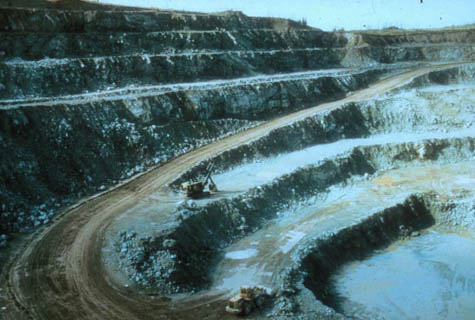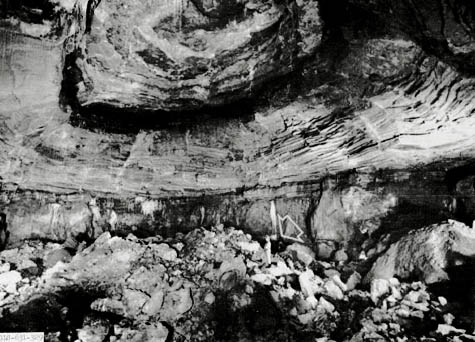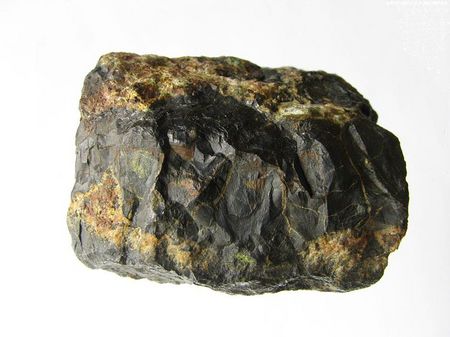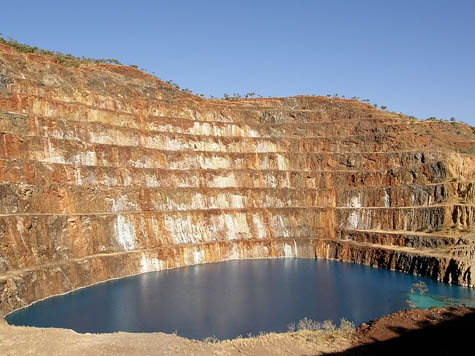Bomb Grid

[Image: The Key Lake uranium mine].
I'm in the process of finishing Tom Zoellner's new book Uranium, and I'm finding it extremely hard to put down. A beautifully written history of the radioactive mineral used in nuclear weapons, it includes some amazing anecdotes and descriptions.
What's particularly interesting about the book, however, as least for me, is that it very firmly locates nuclear weapons as geological devices. That is, atomic bombs are both of and from rocks—they are mineralogy pursued to its most explosive ends, metals transformed into "mammoth amounts of energy," able to level cities and mountains both.
Indeed, uranium, Zoellner writes, is "the mineral of apocalypse." There is "a fearsome animal caged in this exotic metal," he writes, "hot as the sun, but one whose instabilities could be accurately charted and precisely aimed."

[Image: The uranium-powered Fat Man bomb].
There is a moment in John Milton's Paradise Lost, which I mention in The BLDGBLOG Book, where Milton—writing in the 1600s—describes mineral weaponry pulled from the surface of the earth by Satan's minions as they launch an insurrectionary terrorist assault on God. It is geological siege-warfare, we might say.
Milton describes, in Book Six, "materials dark and crude" located "deep under ground"; they "shoot forth / So beauteous, opening to the ambient light" when illuminated by "Heaven's ray." These crude materials, Milton writes, are then rammed down into cannons to form long-range weaponry:
- These in their dark nativity the deep
Shall yield us, pregnant with infernal flame;
Which, into hollow engines, long and round,
Thick rammed, at the other bore with touch of fire
Dilated and infuriate, shall send forth
From far, with thundering noise, among our foes
Such implements of mischief, as shall dash
To pieces, and o'erwhelm whatever stands
Adverse, that they shall fear we have disarmed
The Thunderer of his only dreaded bolt.
At one point, Zoellner himself refers to uranium as "a mineral demon," bringing to mind Milton's Pandemonium—that is, the place of all demons.

[Image: The weaponization of geology in the form of the Little Boy atomic bomb].
In any case, Zoellner's book is full of incredible descriptions. For instance, "Testing [uranium-fueled nuclear weapons] at the Nevada Proving Ground has revealed that a nuclear bomb buried in a deep shaft underneath a mountain would vaporize the surrounding rock and make a huge cathedral-like space inside the earth, ablaze with radioactivity."
Or take Zoellner's short history of something called Project GNOME, which experimentally deployed a small atomic bomb underground in New Mexico in order to see if its detonation could flash-vaporize groundwater, providing steam for a subterranean power plant.

[Image: Inside the underground chamber created by the Project GNOME explosion].
The "muffled bang" of this experiment produced an extraordinary false geology:
- When workers tunneled in more than half a year later to inspect the damage, they found a hollow chamber about the size of the U.S. Capitol dome. The rock walls were colored brilliant shades of blue, green, and purple and bore an angry surface temperature of 140 degrees Fahrenheit. Drilling at the site is prohibited today; the radiation still poses a danger.
- The Monadnock was stone and mortar, and sixteen stories was the breaking point with those materials. Any higher and the whole thing would fall into a pile of rubble, or require walls so big and windows so small that the rooms would have resembled dungeon cells... The building is so obese with masonry that it sank nearly two feet into Chicago's lakefront soil after it opened. It is still the tallest building in the world without a steel frame, and it represents a monument of sorts: the very brink of physical possibility...
There is a similar invisible limitation inside atoms, and uranium is the groaning stone skyscraper among them, pushing the limits of what the universe can tolerate and tossing away its bricks in order to forestall a total collapse. This is radioactivity.

[Image: Yellowcake uranium].
In the Book of Zephaniah, Zoellner points out, no less a figure than God refers to a settlement called Moab, saying it is "a place of weeds and salt pits, a wasteland forever." That a town in Utah might name itself this is either self-deprecation at its most extraordinary or an unfortunate error (indeed, Zoellner mentioned that the town tried, unsuccessfully, to rename itself for several decades).

[Image: Pitchblende, via Wikipedia].
What's fascinating, though, is that uranium was not hard to come by out there; indeed, one could often find these chromosome-mutating, highly radioactive rocks literally just sitting on the surface of the desert, sometimes shining yellow in the arid sunlight. I was thus blown away by a passing comment Zoellner makes when he describes the scabbed desert cliffs, canyons, and hills within which American uranium was found:
- In the shaded alcoves of some of the cliffs, a race of Indians called the Anasazi had left paintings of gazelles and misshapen humans: the people themselves had vanished in the thirteenth century.
I could go on at great length; Uranium is a fascinating book, and, as I mentioned, it takes several steps in the direction of what I might call a geological history of the atomic bomb (something I would love to read or write).

[Image: Abandoned pit of the Mary Kathleen uranium mine, Queensland, Australia; via Wikipedia].
But I was also specifically reminded of the book when I read last night that 10% of the U.S. power grid is fueled by dismantled nuclear warheads—including many purchased from the former Soviet Union.
"Salvaged bomb material now generates about 10 percent of electricity in the United States," the New York Times reports; "by comparison, hydropower generates about 6 percent and solar, biomass, wind and geothermal together account for 3 percent. Utilities have been loath to publicize the Russian bomb supply line for fear of spooking consumers: the fuel from missiles that may have once been aimed at your home may now be lighting it." As one consultant interviewed in the article quips: "'You can look at it like a couple of very large uranium mines,' he said of the fissile material that would result from the program."
Known officially as the Megatons to Megawatts program, it comes with the poetic implication that any forensic dissection of the U.S. national power grid would eventually come up against mineral remnants of Cold War Soviet weaponry. Ticking away somewhere inside the infrastructure of the United States is the radioactive dust of an undeclared nuclear war.
It also makes one wonder what John Milton might do with the U.S. electrical grid—what mythic scenes of electrical warfare, fueled by repurposed missiles and clouds of fallout, he would describe being unleashed upon the scarred bedrock of continents.
But, even at its most mundane, this is stunning: it's as if, on the one hand, we have Hoover Dam, spinning its turbines and sending power to the people of the American southwest, and, on the other, we have an unlocked stockpile of old weapons, like some strange archaeological site, fizzing down somewhere in a power plant, generating light for our cities.





Comments are moderated.
If it's not spam, it will appear here shortly!
I found this entry fascinating, and thank you for the journey. I had not known about Project GNOME, but I did recently write about a related film about America during the era of the A-Bomb that you may or may not have seen: The Atomic Cafe. If you haven't seen it, I HIGHLY recommend. Quick synopsis on my site. [link]
Reading that uranium originates from the compressed organic materials of previous geologic periods (in this case, vegetation and animal life from the Jurassic) was the moment that made this book for me. There is something haunting about organic materials being at the core of this highly volatile rock and all that it has/can unleash. I wished there had been more about this in the book since it is so mysterious and tactile.
There are though, a couple great lines on page 148 that illustrate this a bit,
"It's a little different from other mining because it is dried vegetation, animal life, trees...one time we followed a vein or ore down what looked like a little creek and some timber had fallen in it. We worked down into the rocks and followed that vein up around the rocks and there was this dinosaur. He had jumped into this mud and got stuck, died, and made uranium."
It is perhaps even more interesting and strange to realize in the case of Project Gnome that uranium (former plants and animals) was detonated in what is the remnant of an ancient Permian Sea. Project Gnome was chosen for its geology. The site is located within an enormous salt bed (over 2,00ft thick) called the Salado Formation. This is the same formation in which the Waste Isolation Pilot Plant resides. So it was here, in 1961, that the Jurassic (approx. 150 million years) met the Permian (approx. 250 million years). Perhaps part of what the Anthropocene will be known for is its ability to stage binding contact between vastly disparate geologic periods.
We visited the Gnome site this past July. If you'd like to see some photos of the site above ground see images 10 and 11 in this gallery: http://smudgestudio.org/smudge/32days.html
I also drew a schemata of the site for Freeman Dyson (for a postcard project that I created for the trip). The image is a rollover and you can read a description of what it was like to the be at the site on the "back".
http://smudgestudio.org/smudge/dyson.html
We also produced a field guide to various sites where the nuclear and the geologic converge. It includes driving directions to Gnome: http://smudgestudio.org/smudge/projects/worlds/worlds.html
The office of Legacy Management currently "monitors" the site. You read the official "fact sheet" for the site here: http://www.lm.doe.gov/gnome/Sites.aspx
GNOME was also related to a bigger project called PLOWSHARE, which was about geo-engineering using nuclear weapons. If I remember correctly Glen Seaborg proposed digging canals with underground explosions. As the ground collapsed the channel formed and radioactives were to be trapped by the debreis from above. There is another good doco on this called "Atomic Journeys", directed by Peter Kuran. BTW I grew up near Mary Kathleen mine, a beautiful, arid area!
Reading that uranium originates from the compressed organic materials of previous geologic periods (in this case, vegetation and animal life from the Jurassic) was the moment that made this book for me.
Does the book say that? Sorry to be a wet blanket about an interesting-sounding book, but does the author explain how he thinks that's possible? The Earth, and for that matter our sun, don't have anything like the necessary conditions to form uranium.
This comment has been removed by the author.
The author doesn't explain this other than the quote that I included above (at least that I read) and it is a bit misleading.
Supernovas are the only source of naturally created Uranium.
You can read about the origins of uranium in supernovas here:
http://www.world-nuclear.org/info/inf78.html?sms_ss=email
But dinosaur bones offer concentrated areas of the element as the bones readily bind with Uranium, "Juhani Suksi ... says that radioactivity in the bones originates in the daughters of uranium as a result of the radioactive decay of uranium included in the bone. The uranium ended up in the bone during the long period it was buried in the ground, since uranium is quite a mobile element in such conditions and bone has the tendency to bind to uranium."
- from http://www.helsinki.fi/lehdet/uh/201i.htm
This would explain the high concentration uranium in dinosaur bone deposits, perhaps what Zoellner referenced in his book.
"Dinosaur bones act as radiation magnets, sucking in these uranium ions and giving the bones a higher concentration of uranium than the surrounding soil" - From CNN http://www.cnn.com/TECH/9706/12/t_t/fossil.finder/
'Uranium' was a VERY enlightening read, especially the human rights issues around the world that the demand for it has produced. I thought it was good that Zoellner documented how third world governments sell their mineral rights and the leadership of those countries then hoard the money rather than building power plants, roads, schools and hospitals. I doubt that uranium is the only mineral that produces this type of economy.
I do not recall the author mentioning that uranium originating from compressed organic matter. If he did, I completely missed that. It would have made me skeptical of the book.
Thanks for the Milton quotes, however, I think it was more allegorical than prophetic.
“The Monadnock was stone and mortar, and sixteen stories was the breaking point with those materials. Any higher and the whole thing would fall into a pile of rubble, or require walls so big and windows so small that the rooms would have resembled dungeon cells...”
I don’t understand this claim at all. Any number of cathedrals reach considerably higher than that, in unreinforced stone, and with plentiful windows and slender support columns. Lincoln Cathedral is 83m tall, counting only the stone towers, not its former wooden spire. The dome of St. Paul’s is 80m high, Il Duomo is over 100m, and St. Peter’s Basilica almost 140m. These are all buildings with plentiful windows and beautiful interior light, built centuries before that mere office block. This:
http://en.wikipedia.org/wiki/File:Köln_st_gereon_kuppel_dekagon.jpg
does not resemble a dungeon cell.
Mr Zoellner seems to have accepted some pretty provincial claims for the sake of his metaphor; the Monadnock Building is not the tallest building in the world without a steel frame, and nowhere close to the brink of physical possibility.
This was a brilliant post. Thank you. I now believe that I should pick up this book. It is difficult, in this age, to try to 'depoliticize' Uranium - to try to understand that, lying beneath all of that nuclear power, nuclear weaponry, and the like, that there is this strangely raw power, born out of the bad chemistry of isotopics. It's beautiful and yet, terrifyingly deadly. Hopefully, we'll all gain a healthier respect for this highly useful but deranged metal.
And whoever said that uranium is formed by long-term compression of organic matter has a serious deficiency in understanding basic physics and chemistry.
No one said uranium was formed by long-term compression of organic matter .... but the author of "Uranium" DID quote someone as saying, colloquially, that dinosaurs "made" uranium deposits (by concentrating uranium in their bones). So, hey, the author's informant took a little poetic license. It's STILL amazing that one way to find uranium is to find dinosaur bones, or tress and other organic matter that has concentrated uranium into mine-able deposits. Read the whole book.
From p. 131, to contextualize my original post:
"Thousands of Americans heeded the call and rushed to the canyon country of the Southwest to look for trees that had died a hundred million years ago. The American desert had been swampy and tropical in the Jurassic era; the trees bore bizarre and riotous plumages whose green fibers were replaced almost atom for atom by the liquid uranium solutions rising up through the mudstone like a subterranean fog. The trees soaked up the uranium and lay there entombed in the innards of mesas for more than 150 million years while species above rose and reproduced and fought and fell. The inland sea evaporated and the salt domes began to wither in strange patterns, leaving behind a skeleton jumble of canyons, washes, natural ampitheaters, soaring cliffs stained dark with malachite, and sandstone pillars that resemble skyscrapers or tombstones in the moonlight, some concealing uranium-soaked logs like gold needles in their inner folds. In the shaded alcoves of some of the cliffs, a race of Indians called the Anasazi had left paintings of gazelles and misshapen humans; the people themselves had vanished in the thirteenth century."
Post a Comment